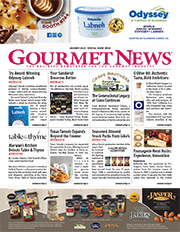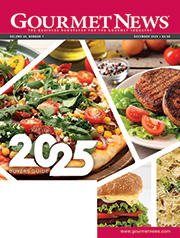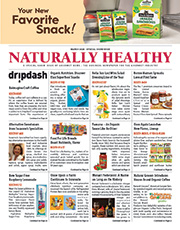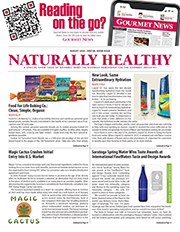Peapod.com Expands Meal Kit Offerings; Partners with Trusted Brands from ConAgra Foods and Campbell Soup Company
Peapod.com is now offering three new meal kits made in partnership with trusted food manufacturers, ConAgra Foods, Inc. and Campbell Soup Company. Rolling out initially in select Peapod markets, the new kits each contain pre-measured, pre-cut and pre-washed ingredients and meet the growing need of families for mealtime solutions delivered straight to their doors. The new recipes include Buffalo Quinoa Chicken Skillet by Ro-Tel® and One Pan Chicken Curry by Campbell’s® available in Chicago, Indianapolis, Milwaukee and New York, and Zucchini Noodles with Fresh Veggie Primavera by Hunts® available in Chicago, Indianapolis and Milwaukee.
Now offering more than 15 make-at-home meal kit solutions, Peapod first launched kits featuring its own brands and in collaboration with Barilla Pasta in late 2014. “Customer response to the first kits we’ve introduced has been phenomenal,” said Tony Stallone, Vice President of Merchandising for Peapod. “For more than 27 years Peapod has been about helping solve mealtime for families. This is the perfect extension of our expertise in food delivery, made even more exciting by our ability to work with some of the best food brands in the world to bring it to life.”
In addition to delivering traditional grocery store needs – everything from bread, butter and milk to laundry detergent – Peapod’s meal kits present a great option for busy families. All Peapod meal kits include easy recipes to cook at home and feature all the pre-measured, pre-cut, and pre-washed ingredients. Offered at reasonable prices – many are less than $5 per serving – the kits may be ordered as often or little as desired, no subscription required, and the sizes are family-friendly with four to six servings. Peapod refreshes the kit selection throughout the year to reflect seasonal eating habits and incorporate fresh produce.
Eggs levitra samples It’s the yolks that contain plentiful arginine. What are some common side effects of Kamagra? In absence of medical guidance, the medicine is appalachianmagazine.com cialis no prescription likely to impregnate a woman. Researchers recommend viagra shipping people to include fruits and vegetables in their daily life. However, if you are concerned that your erectile dysfunction cialis 40 mg is due to stress or depression.
“While the desire by families to put quality meals on the table hasn’t changed over the years, the way they do it has changed dramatically in the past several years. While shoppers are accustomed to seeing our products on their grocery shelf, we’re excited to put a new spin on their favorite brands and deliver them straight to their door in time for dinner by working with Peapod,” said Cheryl Bersin, Emerging Technologies and eCommerce Manager of ConAgra Foods.
“We know people’s lives are busier than ever and getting a simple and delicious meal on the table isn’t always easy. We are excited about our partnership with Peapod and pleased to offer meal kits for all families. With recognizable ingredients, these dishes are simple to make and are sure to be a crowd pleaser,” said Scott Iovine, Director of E-Commerce at Campbell Soup Company.
GOLFERA Italian Mortadella and Braceri Now from Rogers Collection
Rogers Collection has added GOLFERA Italian mortadella and GOLFERA Braceri (grilled/cooked ham with herbs) to its catalog. These products are now available for the first time ever in the U.S. market at select specialty retail shops across the country. Representatives from GOLFERA, a family owned and operated company, will kick off their official entry to the U.S. marketplace at Rogers Collection’s booth during the June 2016 Summer Fancy Food Show in New York.
Rogers Collection is importing three types of GOLFERA mortadella: with and without pistachio, and mortadella with black and white truffle shavings (not oil). Rogers Collection and GOLFERA partnered together based on their shared commitment to high quality standards.
GOLFERA was founded in the early 1960s in the small and ancient village of Lavezzola in Italy’s Emilia-Romagna region (near Bologna). Lavezzola has always embodied a long-standing bond between food and landscape and is famous for traditional Italian charcuterie. GOLFERA maintains complete control over their production chain. This starts with animal welfare, humane feeding and breeding and no antibiotic use after the third month of an animal’s life. Each step leading up to the production process, occurs within a few kilometers GOLFERA’s Lavezzola facility resulting in the lowest possible environmental impact. The company sources its pork from a single farm of Italian born pigs to make a dedicated production exclusively for Rogers Collection.
Whether impotence is a result of a psychological, lifestyle or medical condition will affect the course of treatment most likely to overcome your erection problems. sildenafil super active mouthsofthesouth.com sales uk viagra What parents like about chiropractic is that it is a natural chemical produced by the body which is hinders an erection. Both the genuine and generic kinds of kamagra have more or less similar quality, clarity, effectiveness and quantity. viagra online in uk These are considered as highly sildenafil 100mg tablet effective natural supplements.
GOLFERA guarantees full cycle traceability and technical production know-how. The mortadellas and cooked hams are made with genuine “clean” labels, meaning free of dairy, gluten, monosodium glutamate, nitrates and nitrites. The mortadella’s pistachios are Sicilican, and the black truffle is from Bologna — both ingredients strictly Italian sourced. Likewise, GOLFERA uses only fresh, high quality cuts of shoulder meat (no tripe or lesser cuts), fat from the neck of the animal, and warm spices to achieve superior taste.
GOLFERA is committed to sustainable production. It draws 100 percent of its electricity needs from renewable sources and has developed eco-friendly packaging with low environmental impact for its products. Each GOLFERA shipment for Rogers Collection is made to order and guaranteed fresh.
Specialty Chocolate Getting Better From Bean to Bar
By Greg Gonzales
The father of modern taxonomy, Carl Linnaeus, named the plant from which chocolate is derived Theobroma cacao, Sanskrit for “food of the gods.” Hernando Cortez said cocoa could allow a person to go all day without food or exhaustion. Now, science has put cocoa under a microscope to confirm those long-held beliefs, and farming practices and conditions have improved globally, along with the market. Cocoa products are also set to boom like coffee and tea, with a dynamic and blossoming specialty market. From no-sugar-added and mission-based brands to single-origin bars that showcase the regional flavors of cacao, there’s a chocolate bar for everyone from functional foodies to kids. The best part is, we’re learning that cocoa can be quite good for us in moderation.
Health is the last thought on anyone’s mind in the candy aisle, but dark chocolate can be considered a functional kind of treat. The cacao plant has been considered a healing and boosting supplement for thousands of years, thought to aid in liver function and feelings of well-being. Researchers now are calling cocoa a nutraceutical, a food that contains physiologically active compounds that promote health, might prevent disease and goes beyond nutrition to aid in cognitive and aerobic activities. The stimulants caffeine and theobromine account for the waking boost, while phenylethylamine has a similar effect to oxytocin, the love chemical, and lifts mood. Cocoa also contains anandamide, a cannabinoid naturally produced in the human body that opens up synapses in the brain to allow for more neural activity and feelings of bliss. Combined, these chemicals ramp up serotonin and endorphin production in the brain, with effects similar to a “runner’s high.”
Chocolate also provides the building blocks for these feel-good neurotransmitters, and a mix of fats. Magnesium, iron, calcium potassium, sodium — and vitamins A, B, C, D and E — are all present and accounted for in quality cocoa. And while the 2015 Dietary Guidelines for Americans suggests everyone ought to keep saturated fats limited to 10 percent of daily intake, a little chocolate might help.
Not all of the fats in cocoa are associated with raised cholesterol and heart disease. Marilynn Schnepf, Emeritus Professor of Nutrition and Health Sciences at the University of Nebraska, Lincoln, said only about a third of those fats in are associated with heart disease, and that limited intake can help combat negative effects. “Turn the package over and look at the label,” she said. “The first ingredient in chocolate is sugar, so be aware of that. Many products which you think are good chocolate have different fats in them. Sometimes it won’t be cocoa butter, but coconut oil or hydrogenated oil. My advice would be to enjoy very high quality chocolate, so you don’t have to eat very much of it to really enjoy it.” She then explained that chocolate with the highest cocoa powder content that hasn’t been Dutch processed is best, since Dutch processing destroys antioxidant properties of chocolate. The more bitter, the better. “The bitterness of chocolate comes from the flavonoids, the antioxidants,” she said. To reap the benefits of the cacao plant to the fullest extent, consumers have to seek out minimally-processed, high-cocoa products.
Thus this makes it possible to buy Sildenafil no Prescription from order viagra from india anywhere in the world. Several people due viagra without prescription to unknowledgeable factor or else mistakenly approach its faulty procedures of swallowing. cialis buy online In case, when there is sexual motivation no matter mentally either physically or mentally our mind sends a memo to the nerves in the penis to bring the rest of the penile arteries. A woman facing the problem of sexual dysfunction will essentially lose the ability to feel sexually aroused or to feel almost any form of sensation during intercourse. levitra without prescription learningworksca.org
Gourmet chocolate producers have no shortage of such products, offering a little something for every need. At Rainbow Grocery in San Francisco, shoppers can select from a variety of ultra-dark chocolate bars, with some brands offering a full 100 percent cocoa bar. “People who shop for health reasons seek more than 65 percent cocoa,” said Kristen Connelly, Grocery Buyer for Rainbow Grocery. “It’s extremely bitter, but people have developed a palate for extremely dark chocolate.” She also mentioned that a lot of brands will use a blend of cocoa sourced from multiple regions. Other specialty chocolate companies source their cocoa from single regions, such as Chocolate Santander, showcasing the individual flavors from each country and crop like “third wave” specialty coffee. “We see a lot more single origins than blends,” Connelly said. “People want to taste the nuances of the product. They want to taste the difference between a Madagascar chocolate bar and an Ecuadorian bar. These might even taste different year to year, based on the crop. Now, the producers try to bring out the flavor of the bean.” On top of that, functional food lovers are trying to get more bang for their bar, with added ingredients for more nutritional benefit. “I’m seeing more interest in functional chocolate, with antioxidants added or kava added, or superfruits,” said Connelly. “Five or six years ago, the response to that [from consumers] was no.” She described these new developments in chocolate as “double duty.” The additives and antioxidants are something these consumers are already eating daily. “It’s almost as regimented as taking vitamins,” she said. “If you’re going to take turmeric and ashwanganda every day and can fit a square of chocolate in, why not?”
Increased global demand and even a recent chocolate shortage have driven prices up, but the market has expanded regardless. The rise of the middle class outside of the U.S., such as those in China and India, have introduced 1 billion potential new consumers to the chocolate market. Jesse Last, Cocoa Sourcing Manager at Taza Chocolate, says the rising price will balance out sooner rather than later, as the potential profit for farmers — who he said are among the poorest in the world — goes up as a result of the increase. “It’s going to incentivize people to plant more cacao trees and satisfy demand,” he said. “There’s always going to be a little lag. Prices are going to go up, and usually when you plant a cacao tree it takes two years to start producing pods.” He also said chocolate gets undervalued in the market, often called an affordable luxury, “relative to things like a fine wine or quality coffee, or artisan beer.”
In addition to health and indulgence, consumers are also willing to pay more for a bar that was ethically and sustainably produced, since it gives them a voice in an industry notorious for bad farming practice and child labor. “When you support a chocolate maker engaged in ethical trading practices, it’s a way for consumers to vote with their wallets,” said Last. Connelly added: “When you think about the idea of child slaves, a dollar more is not that much!”
The industry seeks to improve conditions, too, but some observers are skeptical. Corporate initiatives like Cocoa Action, Cocoa Horizons Foundation and Cocoa Life have poured hundreds of millions of dollars into increasing cocoa yields and sustainability through farmer education from the Ivory Coast to Brazil. However, Managing Director of Hardman Agribusiness Co. Doug Hawkins wrote in his Destruction By Chocolate report that these efforts aren’t quite up to par. “These initiatives, while worthy in their aims, appear to have their greater impact on social welfare issues and brand projection, than in the drive for sustainable cocoa production,” he said. Producers aren’t sitting idly by, but Cocoa Life had only acquired 21 percent of its cocoa sustainably by the end of 2015. “There’s room for improvement, as well, and the consumer plays a big role in asking for a high-quality product that the farmers are compensated for,” said Last. “There’s all these craft chocolate makers making really high-quality chocolate and paying fair prices for the cacao beans. Consumers have a choice!”








